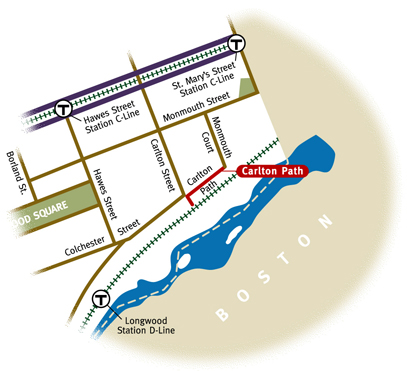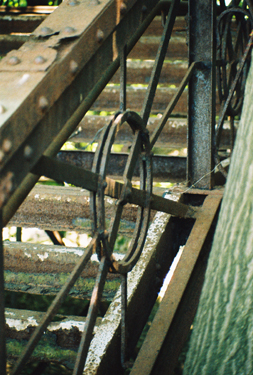Carlton Path by Linda Olson Pehlke
Linda Olson Pehlke is an author and urban planner living in Brookline. Her book, Exploring the Paths of Brookline, is available at Brookline Booksmith and other locations. The series "In Step: Brookline's Paths" was published in Our Town Brookline magazine in 2005 and appears here with the permission of its publisher and the author.
The Longwood Area

The rumbling T cars announce their presence as they rattle alongside Carlton Path, making their way in and out of the nearby Longwood T stop. The tracks lay just beyond the chain link fence on your right, bordering the Riverway portion of the Emerald Necklace. Bicycle and pedestrian paths meander alongside the Muddy River, a part of the great linear park system designed by F.L. Olmsted in the late 1800's that parallels the train tracks.
Beginning at the intersection of Colchester and Carlton Street in Brookline's Longwood area, the path's 263 foot length is a slow descent towards the end of Monmouth Court. On the north side of the path's beginning, a railroad tie planter displays a varied bed of perennials, providing some welcome greenery at eye level. On your right, beyond the chain link fence, verdant overgrowth borders the T tracks. Peaking through the bushes, you can catch a glimpse of the trees and grass-covered riverbank, hinting at the restorative environment that lies just beyond. While traveling the path, it's easy to believe you will be led into the park. Up until the 1970's you were, via the Carlton Street Footbridge.
The Footbridge
Carlton Path, accepted in 1983, and the Footbridge, built in 1894, were clearly planned to complement each other. Together they facilitated access between the Monmouth St. neighborhood and the Riverway. Alexis H. French, Brookline's town engineer, who was working with F.L. Olmsted as he planned and constructed the Riverway from 1881 to 1895, designed the footbridge. Despite the park's natural appearance, every contour, view, planting, and path were carefully designed and specified by Olmsted. In addition, F.L. Olmsted thought a great deal about how his parks would knit into the existing development fabric. This included careful consideration for providing convenient and aesthetically pleasing access to the park, such as the Carlton Street Footbridge. The Footbridge fell into disrepair and was closed in the 1970's, but plans are in the works to restore it to its former glory. Now that the footbridge is closed, pedestrians must travel down Chapel Street to the Longwood T stop to access the park.
Architecture of the Late 19th Century

Many of Brookline's paths are clustered in neighborhoods that were developed as a unit, with the lots, streets, and paths all being laid out at once. Carlton Path however, is a lone amenity, and is the only pedestrian path within the Longwood and Cottage Farm areas. While walking the path, why not take a few moments to admire the area's examples of mid to late 19th century architecture? Near the path's entrance on Colchester Street, French Second Empire and Shingle Style residences are particularly well represented. Monmouth Court, a cul-de-sac running off of Monmouth Street, is lined with townhomes built in 1876 as part of the original Longwood development. These lovely Victorian era townhomes are designed in the gothic revival style. In the heart of the Longwood National Historic District, adjoining streets such as Colchester, Chapel, and Hawes are lined with beautiful homes of the era. Taking pride of place on its hilltop site is the Sears Chapel built in 1867 by David Sears.
© 2010 Linda Olson Pehlke. All rights reserved. No part of this article may be reproduced in any form without prior written permission from the author.
Map by Robert Pehlke. Photographs by Linda Olson Pehlke